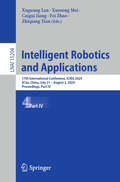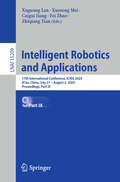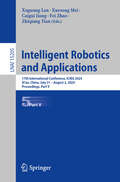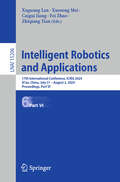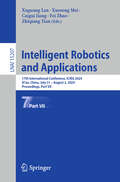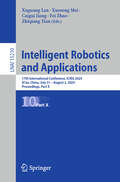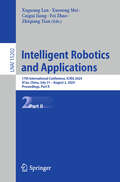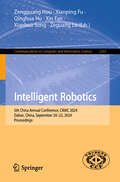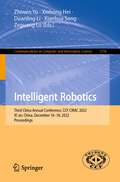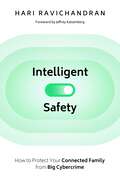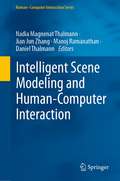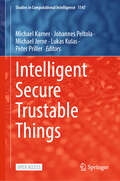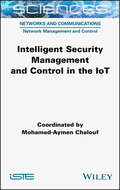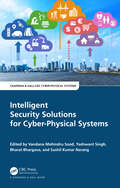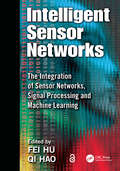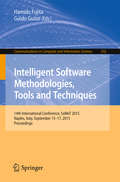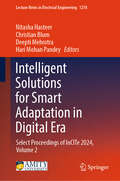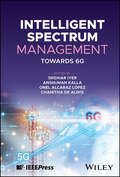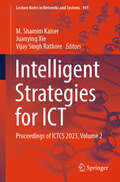- Table View
- List View
Intelligent Robotics and Applications: 17th International Conference, ICIRA 2024, Xi'an, China, July 31 – August 2, 2024, Proceedings, Part IV (Lecture Notes in Computer Science #15204)
by Xuguang Lan Xuesong Mei Caigui Jiang Fei Zhao Zhiqiang TianThe 10-volume set LNAI 15201-15210 constitutes the proceedings of the 17th International Conference on Intelligent Robotics and Applications, ICIRA 2024, which took place in Xi’an, China, during July 31–August 2, 2024. The 321 full papers included in these proceedings were carefully reviewed and selected from 489 submissions. They were organized in topical sections as follows: Part I: Innovative Design and Performance Evaluation of Robot Mechanisms. Part II: Robot Perception and Machine Learning; Cognitive Intelligence and Security Control for Multi-domain Unmanned Vehicle Systems. Part III: Emerging Techniques for Intelligent Robots in Unstructured Environment; Soft Actuators and Sensors; and Advanced Intelligent and Flexible Sensor Technologies for Robotics. Part IV: Optimization and Intelligent Control of Underactuated Robotic Systems; and Technology and application of modular robots. Part V: Advanced actuation and intelligent control in medical robotics: Advancements in Machine Vision for Enhancing Human-Robot Interaction; and Hybrid Decision-making and Control for Intelligent Robots. Part VI: Advances in Marine Robotics; Visual, Linguistic, Affective Agents: Hybrid-augmented Agents for Robotics; and Wearable Robots for Assistance, Augmentation and Rehabilitation of human movements. Part VII: Integrating World Models for Enhanced Robotic Autonomy; Advanced Sensing and Control Technologies for Intelligent Human-Robot Interaction; and Mini-Invasive Robotics for In-Situ Manipulation. Part VIII: Robot Skill Learning and Transfer; Human-Robot Dynamic System: Learning, Modelling and Control; AI-Driven Smart Industrial Systems; and Natural Interaction and Coordinated Collaboration of Robots in Dynamic Unstructured Environments. Part IX: Robotics in Cooperative Manipulation, MultiSensor Fusion, and Multi-Robot Systems; Human-machine Co-adaptive Interface; Brain inspired intelligence for robotics; Planning, control and application of bionic novel concept robots; and Robust Perception for Safe Driving. Part X: AI Robot Technology for Healthcare as a Service; Computational Neuroscience and Cognitive Models for Adaptive Human-Robot Interactions; Dynamics and Perception of Human-Robot Hybrid Systems; and Robotics for Rehabilitation: Innovations, Challenges, and Future Directions.
Intelligent Robotics and Applications: 17th International Conference, ICIRA 2024, Xi'an, China, July 31 – August 2, 2024, Proceedings, Part IX (Lecture Notes in Computer Science #15209)
by Xuguang Lan Xuesong Mei Caigui Jiang Fei Zhao Zhiqiang TianThe 10-volume set LNAI 15201-15210 constitutes the proceedings of the 17th International Conference on Intelligent Robotics and Applications, ICIRA 2024, which took place in Xi’an, China, during July 31–August 2, 2024. The 321 full papers included in these proceedings were carefully reviewed and selected from 489 submissions. They were organized in topical sections as follows: Part I: Innovative Design and Performance Evaluation of Robot Mechanisms. Part II: Robot Perception and Machine Learning; Cognitive Intelligence and Security Control for Multi-domain Unmanned Vehicle Systems. Part III: Emerging Techniques for Intelligent Robots in Unstructured Environment; Soft Actuators and Sensors; and Advanced Intelligent and Flexible Sensor Technologies for Robotics. Part IV: Optimization and Intelligent Control of Underactuated Robotic Systems; and Technology and application of modular robots. Part V: Advanced actuation and intelligent control in medical robotics: Advancements in Machine Vision for Enhancing Human-Robot Interaction; and Hybrid Decision-making and Control for Intelligent Robots. Part VI: Advances in Marine Robotics; Visual, Linguistic, Affective Agents: Hybrid-augmented Agents for Robotics; and Wearable Robots for Assistance, Augmentation and Rehabilitation of human movements. Part VII: Integrating World Models for Enhanced Robotic Autonomy; Advanced Sensing and Control Technologies for Intelligent Human-Robot Interaction; and Mini-Invasive Robotics for In-Situ Manipulation. Part VIII: Robot Skill Learning and Transfer; Human-Robot Dynamic System: Learning, Modelling and Control; AI-Driven Smart Industrial Systems; and Natural Interaction and Coordinated Collaboration of Robots in Dynamic Unstructured Environments. Part IX: Robotics in Cooperative Manipulation, MultiSensor Fusion, and Multi-Robot Systems; Human-machine Co-adaptive Interface; Brain inspired intelligence for robotics; Planning, control and application of bionic novel concept robots; and Robust Perception for Safe Driving. Part X: AI Robot Technology for Healthcare as a Service; Computational Neuroscience and Cognitive Models for Adaptive Human-Robot Interactions; Dynamics and Perception of Human-Robot Hybrid Systems; and Robotics for Rehabilitation: Innovations, Challenges, and Future Directions.
Intelligent Robotics and Applications: 17th International Conference, ICIRA 2024, Xi'an, China, July 31 – August 2, 2024, Proceedings, Part V (Lecture Notes in Computer Science #15205)
by Xuguang Lan Xuesong Mei Caigui Jiang Fei Zhao Zhiqiang TianThe 10-volume set LNAI 15201-15210 constitutes the proceedings of the 17th International Conference on Intelligent Robotics and Applications, ICIRA 2024, which took place in Xi’an, China, during July 31–August 2, 2024. The 321 full papers included in these proceedings were carefully reviewed and selected from 489 submissions. They were organized in topical sections as follows: Part I: Innovative Design and Performance Evaluation of Robot Mechanisms. Part II: Robot Perception and Machine Learning; Cognitive Intelligence and Security Control for Multi-domain Unmanned Vehicle Systems. Part III: Emerging Techniques for Intelligent Robots in Unstructured Environment; Soft Actuators and Sensors; and Advanced Intelligent and Flexible Sensor Technologies for Robotics. Part IV: Optimization and Intelligent Control of Underactuated Robotic Systems; and Technology and application of modular robots. Part V: Advanced actuation and intelligent control in medical robotics: Advancements in Machine Vision for Enhancing Human-Robot Interaction; and Hybrid Decision-making and Control for Intelligent Robots. Part VI: Advances in Marine Robotics; Visual, Linguistic, Affective Agents: Hybrid-augmented Agents for Robotics; and Wearable Robots for Assistance, Augmentation and Rehabilitation of human movements. Part VII: Integrating World Models for Enhanced Robotic Autonomy; Advanced Sensing and Control Technologies for Intelligent Human-Robot Interaction; and Mini-Invasive Robotics for In-Situ Manipulation. Part VIII: Robot Skill Learning and Transfer; Human-Robot Dynamic System: Learning, Modelling and Control; AI-Driven Smart Industrial Systems; and Natural Interaction and Coordinated Collaboration of Robots in Dynamic Unstructured Environments. Part IX: Robotics in Cooperative Manipulation, MultiSensor Fusion, and Multi-Robot Systems; Human-machine Co-adaptive Interface; Brain inspired intelligence for robotics; Planning, control and application of bionic novel concept robots; and Robust Perception for Safe Driving. Part X: AI Robot Technology for Healthcare as a Service; Computational Neuroscience and Cognitive Models for Adaptive Human-Robot Interactions; Dynamics and Perception of Human-Robot Hybrid Systems; and Robotics for Rehabilitation: Innovations, Challenges, and Future Directions.
Intelligent Robotics and Applications: 17th International Conference, ICIRA 2024, Xi'an, China, July 31 – August 2, 2024, Proceedings, Part VI (Lecture Notes in Computer Science #15206)
by Xuguang Lan Xuesong Mei Caigui Jiang Fei Zhao Zhiqiang TianThe 10-volume set LNAI 15201-15210 constitutes the proceedings of the 17th International Conference on Intelligent Robotics and Applications, ICIRA 2024, which took place in Xi’an, China, during July 31–August 2, 2024. The 321 full papers included in these proceedings were carefully reviewed and selected from 489 submissions. They were organized in topical sections as follows: Part I: Innovative Design and Performance Evaluation of Robot Mechanisms. Part II: Robot Perception and Machine Learning; Cognitive Intelligence and Security Control for Multi-domain Unmanned Vehicle Systems. Part III: Emerging Techniques for Intelligent Robots in Unstructured Environment; Soft Actuators and Sensors; and Advanced Intelligent and Flexible Sensor Technologies for Robotics. Part IV: Optimization and Intelligent Control of Underactuated Robotic Systems; and Technology and application of modular robots. Part V: Advanced actuation and intelligent control in medical robotics: Advancements in Machine Vision for Enhancing Human-Robot Interaction; and Hybrid Decision-making and Control for Intelligent Robots. Part VI: Advances in Marine Robotics; Visual, Linguistic, Affective Agents: Hybrid-augmented Agents for Robotics; and Wearable Robots for Assistance, Augmentation and Rehabilitation of human movements. Part VII: Integrating World Models for Enhanced Robotic Autonomy; Advanced Sensing and Control Technologies for Intelligent Human-Robot Interaction; and Mini-Invasive Robotics for In-Situ Manipulation. Part VIII: Robot Skill Learning and Transfer; Human-Robot Dynamic System: Learning, Modelling and Control; AI-Driven Smart Industrial Systems; and Natural Interaction and Coordinated Collaboration of Robots in Dynamic Unstructured Environments. Part IX: Robotics in Cooperative Manipulation, MultiSensor Fusion, and Multi-Robot Systems; Human-machine Co-adaptive Interface; Brain inspired intelligence for robotics; Planning, control and application of bionic novel concept robots; and Robust Perception for Safe Driving. Part X: AI Robot Technology for Healthcare as a Service; Computational Neuroscience and Cognitive Models for Adaptive Human-Robot Interactions; Dynamics and Perception of Human-Robot Hybrid Systems; and Robotics for Rehabilitation: Innovations, Challenges, and Future Directions.
Intelligent Robotics and Applications: 17th International Conference, ICIRA 2024, Xi'an, China, July 31 – August 2, 2024, Proceedings, Part VII (Lecture Notes in Computer Science #15207)
by Xuguang Lan Xuesong Mei Caigui Jiang Fei Zhao Zhiqiang TianThe 10-volume set LNAI 15201-15210 constitutes the proceedings of the 17th International Conference on Intelligent Robotics and Applications, ICIRA 2024, which took place in Xi’an, China, during July 31–August 2, 2024. The 321 full papers included in these proceedings were carefully reviewed and selected from 489 submissions. They were organized in topical sections as follows: Part I: Innovative Design and Performance Evaluation of Robot Mechanisms. Part II: Robot Perception and Machine Learning; Cognitive Intelligence and Security Control for Multi-domain Unmanned Vehicle Systems. Part III: Emerging Techniques for Intelligent Robots in Unstructured Environment; Soft Actuators and Sensors; and Advanced Intelligent and Flexible Sensor Technologies for Robotics. Part IV: Optimization and Intelligent Control of Underactuated Robotic Systems; and Technology and application of modular robots. Part V: Advanced actuation and intelligent control in medical robotics: Advancements in Machine Vision for Enhancing Human-Robot Interaction; and Hybrid Decision-making and Control for Intelligent Robots. Part VI: Advances in Marine Robotics; Visual, Linguistic, Affective Agents: Hybrid-augmented Agents for Robotics; and Wearable Robots for Assistance, Augmentation and Rehabilitation of human movements. Part VII: Integrating World Models for Enhanced Robotic Autonomy; Advanced Sensing and Control Technologies for Intelligent Human-Robot Interaction; and Mini-Invasive Robotics for In-Situ Manipulation. Part VIII: Robot Skill Learning and Transfer; Human-Robot Dynamic System: Learning, Modelling and Control; AI-Driven Smart Industrial Systems; and Natural Interaction and Coordinated Collaboration of Robots in Dynamic Unstructured Environments. Part IX: Robotics in Cooperative Manipulation, MultiSensor Fusion, and Multi-Robot Systems; Human-machine Co-adaptive Interface; Brain inspired intelligence for robotics; Planning, control and application of bionic novel concept robots; and Robust Perception for Safe Driving. Part X: AI Robot Technology for Healthcare as a Service; Computational Neuroscience and Cognitive Models for Adaptive Human-Robot Interactions; Dynamics and Perception of Human-Robot Hybrid Systems; and Robotics for Rehabilitation: Innovations, Challenges, and Future Directions.
Intelligent Robotics and Applications: 17th International Conference, ICIRA 2024, Xi'an, China, July 31 – August 2, 2024, Proceedings, Part VIII (Lecture Notes in Computer Science #15208)
by Xuguang Lan Xuesong Mei Caigui Jiang Fei Zhao Zhiqiang TianThe 10-volume set LNAI 15201-15210 constitutes the proceedings of the 17th International Conference on Intelligent Robotics and Applications, ICIRA 2024, which took place in Xi’an, China, during July 31–August 2, 2024. The 321 full papers included in these proceedings were carefully reviewed and selected from 489 submissions. They were organized in topical sections as follows: Part I: Innovative Design and Performance Evaluation of Robot Mechanisms. Part II: Robot Perception and Machine Learning; Cognitive Intelligence and Security Control for Multi-domain Unmanned Vehicle Systems. Part III: Emerging Techniques for Intelligent Robots in Unstructured Environment; Soft Actuators and Sensors; and Advanced Intelligent and Flexible Sensor Technologies for Robotics. Part IV: Optimization and Intelligent Control of Underactuated Robotic Systems; and Technology and application of modular robots. Part V: Advanced actuation and intelligent control in medical robotics: Advancements in Machine Vision for Enhancing Human-Robot Interaction; and Hybrid Decision-making and Control for Intelligent Robots. Part VI: Advances in Marine Robotics; Visual, Linguistic, Affective Agents: Hybrid-augmented Agents for Robotics; and Wearable Robots for Assistance, Augmentation and Rehabilitation of human movements. Part VII: Integrating World Models for Enhanced Robotic Autonomy; Advanced Sensing and Control Technologies for Intelligent Human-Robot Interaction; and Mini-Invasive Robotics for In-Situ Manipulation. Part VIII: Robot Skill Learning and Transfer; Human-Robot Dynamic System: Learning, Modelling and Control; AI-Driven Smart Industrial Systems; and Natural Interaction and Coordinated Collaboration of Robots in Dynamic Unstructured Environments. Part IX: Robotics in Cooperative Manipulation, MultiSensor Fusion, and Multi-Robot Systems; Human-machine Co-adaptive Interface; Brain inspired intelligence for robotics; Planning, control and application of bionic novel concept robots; and Robust Perception for Safe Driving. Part X: AI Robot Technology for Healthcare as a Service; Computational Neuroscience and Cognitive Models for Adaptive Human-Robot Interactions; Dynamics and Perception of Human-Robot Hybrid Systems; and Robotics for Rehabilitation: Innovations, Challenges, and Future Directions.
Intelligent Robotics and Applications: 17th International Conference, ICIRA 2024, Xi'an, China, July 31–August 2, 2024, Proceedings, Part X (Lecture Notes in Computer Science #15210)
by Xuguang Lan Xuesong Mei Caigui Jiang Fei Zhao Zhiqiang TianThe 10-volume set LNAI 15201-15210 constitutes the proceedings of the 17th International Conference on Intelligent Robotics and Applications, ICIRA 2024, which took place in Xi’an, China, during July 31–August 2, 2024. The 321 full papers included in these proceedings were carefully reviewed and selected from 489 submissions. They were organized in topical sections as follows: Part I: Innovative Design and Performance Evaluation of Robot Mechanisms. Part II: Robot Perception and Machine Learning; Cognitive Intelligence and Security Control for Multi-domain Unmanned Vehicle Systems. Part III: Emerging Techniques for Intelligent Robots in Unstructured Environment; Soft Actuators and Sensors; and Advanced Intelligent and Flexible Sensor Technologies for Robotics. Part IV: Optimization and Intelligent Control of Underactuated Robotic Systems; and Technology and application of modular robots. Part V: Advanced actuation and intelligent control in medical robotics: Advancements in Machine Vision for Enhancing Human-Robot Interaction; and Hybrid Decision-making and Control for Intelligent Robots. Part VI: Advances in Marine Robotics; Visual, Linguistic, Affective Agents: Hybrid-augmented Agents for Robotics; and Wearable Robots for Assistance, Augmentation and Rehabilitation of human movements. Part VII: Integrating World Models for Enhanced Robotic Autonomy; Advanced Sensing and Control Technologies for Intelligent Human-Robot Interaction; and Mini-Invasive Robotics for In-Situ Manipulation. Part VIII: Robot Skill Learning and Transfer; Human-Robot Dynamic System: Learning, Modelling and Control; AI-Driven Smart Industrial Systems; and Natural Interaction and Coordinated Collaboration of Robots in Dynamic Unstructured Environments. Part IX: Robotics in Cooperative Manipulation, MultiSensor Fusion, and Multi-Robot Systems; Human-machine Co-adaptive Interface; Brain inspired intelligence for robotics; Planning, control and application of bionic novel concept robots; and Robust Perception for Safe Driving. Part X: AI Robot Technology for Healthcare as a Service; Computational Neuroscience and Cognitive Models for Adaptive Human-Robot Interactions; Dynamics and Perception of Human-Robot Hybrid Systems; and Robotics for Rehabilitation: Innovations, Challenges, and Future Directions.
Intelligent Robotics and Applications: 17th International Conference, ICIRA 2024, Xi’an, China, July 31 – August 2, 2024, Proceedings, Part II (Lecture Notes in Computer Science #15202)
by Xuguang Lan Xuesong Mei Caigui Jiang Fei Zhao Zhiqiang TianThe 10-volume set LNAI 15201-15210 constitutes the proceedings of the 17th International Conference on Intelligent Robotics and Applications, ICIRA 2024, which took place in Xi’an, China, during July 31–August 2, 2024. The 321 full papers included in these proceedings were carefully reviewed and selected from 489 submissions. They were organized in topical sections as follows: Part I: Innovative Design and Performance Evaluation of Robot Mechanisms. Part II: Robot Perception and Machine Learning; Cognitive Intelligence and Security Control for Multi-domain Unmanned Vehicle Systems. Part III: Emerging Techniques for Intelligent Robots in Unstructured Environment; Soft Actuators and Sensors; and Advanced Intelligent and Flexible Sensor Technologies for Robotics. Part IV: Optimization and Intelligent Control of Underactuated Robotic Systems; and Technology and application of modular robots. Part V: Advanced actuation and intelligent control in medical robotics: Advancements in Machine Vision for Enhancing Human-Robot Interaction; and Hybrid Decision-making and Control for Intelligent Robots. Part VI: Advances in Marine Robotics; Visual, Linguistic, Affective Agents: Hybrid-augmented Agents for Robotics; and Wearable Robots for Assistance, Augmentation and Rehabilitation of human movements. Part VII: Integrating World Models for Enhanced Robotic Autonomy; Advanced Sensing and Control Technologies for Intelligent Human-Robot Interaction; and Mini-Invasive Robotics for In-Situ Manipulation. Part VIII: Robot Skill Learning and Transfer; Human-Robot Dynamic System: Learning, Modelling and Control; AI-Driven Smart Industrial Systems; and Natural Interaction and Coordinated Collaboration of Robots in Dynamic Unstructured Environments. Part IX: Robotics in Cooperative Manipulation, MultiSensor Fusion, and Multi-Robot Systems; Human-machine Co-adaptive Interface; Brain inspired intelligence for robotics; Planning, control and application of bionic novel concept robots; and Robust Perception for Safe Driving. Part X: AI Robot Technology for Healthcare as a Service; Computational Neuroscience and Cognitive Models for Adaptive Human-Robot Interactions; Dynamics and Perception of Human-Robot Hybrid Systems; and Robotics for Rehabilitation: Innovations, Challenges, and Future Directions.
Intelligent Robotics: 5th China Annual Conference, CIRAC 2024, Dalian, China, September 20–22, 2024, Proceedings (Communications in Computer and Information Science #2355)
by Xianhua Song Zeguang Lu Qinghua Hu Xin Fan Zengguang Hou Xianping FuThis book constitutes selected papers presented during the 5th China Annual Intelligent Robotics Conference, CIRAC 2024, held in Dalian, China, in September 2024. The 28 full papers presented in this volume were carefully reviewed and selected from 96 submissions. They are grouped into the following topics: Deep Learning Architecture; Low-Level Vision; Multi-modal learning; Pattern Recognition; Robotics; and Signal processing.
Intelligent Robotics: Third China Annual Conference, CCF CIRAC 2022, Xi’an, China, December 16–18, 2022, Proceedings (Communications in Computer and Information Science #1770)
by Xianhua Song Zeguang Lu Zhiwen Yu Xinhong Hei Duanling LiThis book constitutes selected papers presented during the Third China Annual Intelligent Robotics Conference, CCF CIRAC 2022, held in Xi' an, China, in December 2022. The 35 papers presented were thoroughly reviewed and selected from the 120 qualified submissions. They are organized in the following topical sections: robot safety; intelligent robot sensing; autonomous robot navigation; artificial intelligence and cloud robot; unmanned cluster collaboration; natural human-computer interaction; other robot-related technologies.
Intelligent Safety: How to Protect Your Connected Family from Big Cybercrime
by Hari RavichandranTurn the tables on cybercriminals. Keep your loved ones safe. We live much of our personal and professional lives online, but fraudsters and hackers have made the internet dangerous. Cyberattacks are the US&’s fastest growing crime: consumers lost more than $6.9 billion to fraud in 2021, up more than 50% from 2020; financial losses from online theft surpassed losses from home theft; 1 in 10 people become identity theft victims annually, including more than 1 million children. So how do we keep our kids, parents, colleagues, and selves safe against organized cybercriminals with their increasingly advanced tools?Intelligent Safety: How to Protect Your Connected Family from Big Cybercrime teaches how we can put our families&’ online safety on autopilot and regain our peace of mind. It provides families with the tools and knowledge they need to create a personalized, proactive defense against cybercriminals. From identifying the risks of your teen&’s secret online life to safeguarding your family finances to defending the vulnerabilities of your aging parents, Intelligent Safety is the last guide you&’ll need to beat cyber predators at their own game.
Intelligent Scene Modeling and Human-Computer Interaction (Human–Computer Interaction Series)
by Daniel Thalmann Nadia Magnenat Thalmann Jian Jun Zhang Manoj RamanathanThis edited book is one of the first to describe how Autonomous Virtual Humans and Social Robots can interact with real people and be aware of the surrounding world using machine learning and AI. It includes:· Many algorithms related to the awareness of the surrounding world such as the recognition of objects, the interpretation of various sources of data provided by cameras, microphones, and wearable sensors· Deep Learning Methods to provide solutions to Visual Attention, Quality Perception, and Visual Material Recognition· How Face Recognition and Speech Synthesis will replace the traditional mouse and keyboard interfaces· Semantic modeling and rendering and shows how these domains play an important role in Virtual and Augmented Reality Applications.Intelligent Scene Modeling and Human-Computer Interaction explains how to understand the composition and build very complex scenes and emphasizes the semantic methods needed to have an intelligent interaction with them. It offers readers a unique opportunity to comprehend the rapid changes and continuous development in the fields of Intelligent Scene Modeling.
Intelligent Secure Trustable Things (Studies in Computational Intelligence #1147)
by Michael Karner Johannes Peltola Michael Jerne Lukas Kulas Peter PrillerThis open access book provides an overview about results of the InSecTT project. Artificial Intelligence of Things (AIoT) is the natural evolution for both Artificial Intelligence (AI) and Internet of Things (IoT) because they are mutually beneficial. AI increases the value of the IoT through machine learning by transforming the data into useful information, while the IoT increases the value of AI through connectivity and data exchange. Therefore, InSecTT—Intelligent Secure Trustable Things, a pan-European effort with over 50 key partners from 12 countries (EU and Turkey), provides intelligent, secure and trustworthy systems for industrial applications to provide comprehensive cost-efficient solutions of intelligent, end-to-end secure, trustworthy connectivity and interoperability to bring the Internet of Things and Artificial Intelligence together. InSecTT creates trust in AI-based intelligent systems and solutions as a major part of the AIoT. InSecTT fosters cooperation between big industrial players from various domains, a number of highly innovative SMEs distributed all over Europe and cutting-edge research organizations and universities. The project features a big variety of industry-driven use cases embedded into various application domains where Europe is in a leading position, i.e., smart infrastructure, building, manufacturing, automotive, aeronautics, railway, urban public transport, maritime as well as health. The demonstration of InSecTT solutions in well-known real-world environments like airports, trains, ports and the health sector shows their applicability on both high and broad level, going from citizens to European stakeholders. The first part of the book provides an introduction into the main topics of the InSecTT project: How to bring Internet of Things and Artificial Intelligence together to form the Artificial Intelligence of Things, a reference architecture for such kind of systems and how to develop trustworthy, ethical AI systems. In the second part, we show the development of essential technologies for creating trustworthy AIoT systems. The third part of the book is composed of a broad variety of examples on how to design, develop and validate trustworthy AIoT systems for industrial applications (including automotive, avionics, smart infrastructure, health care, manufacturing and railway).
Intelligent Security Management and Control in the IoT
by Mohamed-Aymen ChaloufThe Internet of Things (IoT) has contributed greatly to the growth of data traffic on the Internet. Access technologies and object constraints associated with the IoT can cause performance and security problems. This relates to important challenges such as the control of radio communications and network access, the management of service quality and energy consumption, and the implementation of security mechanisms dedicated to the IoT.In response to these issues, this book presents new solutions for the management and control of performance and security in the IoT. The originality of these proposals lies mainly in the use of intelligent techniques. This notion of intelligence allows, among other things, the support of object heterogeneity and limited capacities as well as the vast dynamics characterizing the IoT.
Intelligent Security Solutions for Cyber-Physical Systems (Chapman & Hall/CRC Cyber-Physical Systems)
by Bharat Bhargava Yashwant Singh Vandana Mohindru Sood Sushil Kumar NarangA cyber-physical system (CPS) is a computer system in which a mechanism is controlled or monitored by computer-based algorithms and involves transdisciplinary approaches, merging theories of cybernetics, mechatronics, design, and process science. This text mainly concentrates on offering a foundational theoretical underpinning, and a comprehensive and coherent review of intelligent security solutions for cyber-physical systems. Features: • Provides an overview of cyber-physical systems (CPSs) along with security concepts like attack detection methods, cyber-physical systems failures, and risk identification and management. • Showcases cyber-physical systems (CPSs) security solutions, lightweight cryptographic solutions, and CPS forensics, etc. • Emphasizes machine learning methods for behavior-based intrusion detection in cyber-physical systems (CPSs), resilient machine learning for networked CPS, fog computing industrial CPS, etc. • Elaborates classification of network abnormalities in Internet of Things-based cyber-physical systems (CPSs) using deep learning. • Includes case studies and applications in the domain of smart grid systems, industrial control systems, smart manufacturing, social network and gaming, electric power grid and energy systems, etc.
Intelligent Security Systems: How Artificial Intelligence, Machine Learning and Data Science Work For and Against Computer Security
by Leon ReznikINTELLIGENT SECURITY SYSTEMS Dramatically improve your cybersecurity using AI and machine learning In Intelligent Security Systems, distinguished professor and computer scientist Dr. Leon Reznik delivers an expert synthesis of artificial intelligence, machine learning and data science techniques, applied to computer security to assist readers in hardening their computer systems against threats. Emphasizing practical and actionable strategies that can be immediately implemented by industry professionals and computer device’s owners, the author explains how to install and harden firewalls, intrusion detection systems, attack recognition tools, and malware protection systems. He also explains how to recognize and counter common hacking activities. This book bridges the gap between cybersecurity education and new data science programs, discussing how cutting-edge artificial intelligence and machine learning techniques can work for and against cybersecurity efforts. Intelligent Security Systems includes supplementary resources on an author-hosted website, such as classroom presentation slides, sample review, test and exam questions, and practice exercises to make the material contained practical and useful. The book also offers: A thorough introduction to computer security, artificial intelligence, and machine learning, including basic definitions and concepts like threats, vulnerabilities, risks, attacks, protection, and tools An exploration of firewall design and implementation, including firewall types and models, typical designs and configurations, and their limitations and problems Discussions of intrusion detection systems (IDS), including architecture topologies, components, and operational ranges, classification approaches, and machine learning techniques in IDS design A treatment of malware and vulnerabilities detection and protection, including malware classes, history, and development trends Perfect for undergraduate and graduate students in computer security, computer science and engineering, Intelligent Security Systems will also earn a place in the libraries of students and educators in information technology and data science, as well as professionals working in those fields.
Intelligent Sensor Networks: The Integration of Sensor Networks, Signal Processing and Machine Learning
by Fei HuIn the last decade, wireless or wired sensor networks have attracted much attention. However, most designs target general sensor network issues including protocol stack (routing, MAC, etc.) and security issues. This book focuses on the close integration of sensing, networking, and smart signal processing via machine learning. Based on their world-class research, the authors present the fundamentals of intelligent sensor networks. They cover sensing and sampling, distributed signal processing, and intelligent signal learning. In addition, they present cutting-edge research results from leading experts.
Intelligent Software Defect Prediction
by Baowen Xu Xiao-Yuan Jing Haowen ChenWith the increasing complexity of and dependency on software, software products may suffer from low quality, high prices, be hard to maintain, etc. Software defects usually produce incorrect or unexpected results and behaviors. Accordingly, software defect prediction (SDP) is one of the most active research fields in software engineering and plays an important role in software quality assurance. Based on the results of SDP analyses, developers can subsequently conduct defect localization and repair on the basis of reasonable resource allocation, which helps to reduce their maintenance costs. This book offers a comprehensive picture of the current state of SDP research. More specifically, it introduces a range of machine-learning-based SDP approaches proposed for different scenarios (i.e., WPDP, CPDP, and HDP). In addition, the book shares in-depth insights into current SDP approaches’ performance and lessons learned for future SDP research efforts. We believe these theoretical analyses and emerging challenges will be of considerable interest to all researchers, graduate students, and practitioners who want to gain deeper insights into and/or find new research directions in SDP. It offers a comprehensive introduction to the current state of SDP and detailed descriptions of representative SDP approaches.
Intelligent Software Methodologies, Tools and Techniques
by Hamido Fujita Ali SelamatThis book constitutes the best papers selection from the proceedings of the 13th International Conference on Intelligent Software Methodologies, Tools and Techniques, SoMeT 2014, held in Langkawi, Malaysia, in September 2014. The 27 full papers presented were carefully reviewed, thoroughly revised or enlarged, and selected as best papers from the 79 published proceedings papers, which had originally been selected from 192 submissions. The papers are organized in topical sections on artificial intelligence techniques in software engineering; requirement engineering, high-assurance system; intelligent software systems design; creative and arts in interactive software design; software methodologies for reliable software design; software quality and assessment for business enterprise; software analysis and performance model; software applications systems.
Intelligent Software Methodologies, Tools and Techniques
by Hamido Fujita Guido GuizziThis book constitutes the best papers selection from the proceedings of the 14th International Conference on Intelligent Software Methodologies, Tools and Techniques, SoMeT 2015, held in Naples, Italy, in September 2015. The 47 full papers presented together with one short paper were carefully reviewed and selected from 118 submissions. The papers are organized in topical sections on embedded and mobile software systems, theory and application; real-time systems; requirement engineering, high-assurance and testing system; social networks and big data; cloud computing and semantic web; artificial intelligence techniques and intelligent system design; software development and integration; security and software methodologies for reliable software design; new software techniques in image processing and computer graphics; software applications systems for medical health care.
Intelligent Solutions for Smart Adaptation in Digital Era: Select Proceedings of InCITe 2024, Volume 2 (Lecture Notes in Electrical Engineering #1278)
by Christian Blum Hari Mohan Pandey Nitasha Hasteer Deepti MehrotraThis book comprises the select peer-reviewed proceedings of the 4th International Conference on Information Technology (InCITe-2024). It aims to provide a comprehensive knowledge base highlighting state-of-the-art research and development and best practices for intelligent solutions in the digital era. It covers adaptive intelligence, decision intelligence, artificial intelligence, deep learning, machine learning, data science, and enabling technologies for IoT, blockchain, and other futuristic technologies. The content would serve as a rich knowledge repository on information & communication technologies, neural networks, fuzzy systems, natural language processing, data mining & warehousing, big data analytics, cloud computing, social networks and intelligence, decision-making, and modeling, information systems, IT architectures, and security related aspects. This book provides a valuable resource for those in academia and industry.
Intelligent Spectrum Handovers in Cognitive Radio Networks (EAI/Springer Innovations in Communication and Computing)
by Anandakumar Haldorai Umamaheswari KandaswamyThis book highlights the need for an efficient Handover Decision (HD) mechanism to perform switches from one network to another and to provide unified and continuous mobile services that include seamless connectivity and ubiquitous service access. The author shows how the HD involves efficiently combining handover initiation and network selection process. The author describes how the network selection decision is a challenging task that is a central component to making HD for any mobile user in a heterogeneous environment that involves a number of static and dynamic parameters. The author also discusses prevailing technical challenges like Dynamic Spectrum Allocation (DSA) methods, spectrum sensing, cooperative communications, cognitive network architecture protocol design, cognitive network security challenges and dynamic adaptation algorithms for cognitive system and the evolving behavior of systems in general. The book allows the reader to optimize the sensing time for maximizing the spectrum utilization, improve the lifetime of the cognitive radio network (CRN) using active scan spectrum sensing techniques, analyze energy efficiency of CRN, find a secondary user spectrum allocation, perform dynamic handovers, and use efficient data communication in the cognitive networks.Identifies energy efficient spectrum sensing techniques for Cooperative Cognitive Radio Networks (CRN);Shows how to maximize the energy capacity by minimizing the outage probability;Features end-of-chapter summaries, performance measures, and case studies.
Intelligent Spectrum Management: Towards 6G
by Sridhar Iyer Anshuman Kalla Onel Alcaraz López Chamitha De AlwisForward-thinking reference on spectrum sharing and resource management for 5G, B5G, and 6G wireless networks Intelligent Spectrum Management: Towards 6G explores various aspects of spectrum sharing and resource management in 5G, beyond 5G, and the envisaged 6G networks. The book offers an in-depth exploration of intelligent and secure sharing of spectrum and resource management in existing and future mobile networks. The book sets the stage by providing an insight to the evolution of mobile networks and highlights the importance of spectrum sharing and resource management in next-generation wireless networks. At the core, the book explores various promising technologies such as cognitive radio, reinforcement learning, deep learning, reconfigurable intelligent surfaces, and blockchain technology towards efficient, intelligent, and secure sharing of spectrum and resource management. Moreover, the book presents dynamic and decentralized resource management techniques, including network slicing, game theory, and blockchain-enabled approaches. Topics covered include: Spectrum, and why it must be utilized optimally and transparentlyFuture applications envisioned with 6G, such as digital twins, Industry 5.0, holographic telepresence, and Extended Reality (XR)Challenges when Dynamic Spectrum Management (DSM) is enabled through Machine Learning (ML) techniques, including the complexity of received signals and the difficulty in obtaining accurate network data such as channel state informationReinforcement learning and deep learning-assisted spectrum management Synergy between Artificial Intelligence (AI) and blockchain technology for spectrum managementPrivate networks, including their prospects, architecture, enabling concepts, and techniques for efficient operation In essence, various innovative technologies and approaches that can be leveraged to enhance spectrum utilization and efficiently manage network resources are discussed. The book is a potential reference for researchers, academics, and professionals in the wireless service provider industry, as well as regulators and officials.
Intelligent Strategies for ICT: Proceedings of ICTCS 2023, Volume 2 (Lecture Notes in Networks and Systems #941)
by Vijay Singh Rathore M. Shamim Kaiser Juanying XieThis book contains best selected research papers presented at ICTCS 2023: Eighth International Conference on Information and Communication Technology for Competitive Strategies. The conference was held in Jaipur, India during 8 – 9 December 2023. The book covers state-of-the-art as well as emerging topics pertaining to ICT and effective strategies for its implementation for engineering and managerial applications. This book contains papers mainly focused on ICT for computation, algorithms and data analytics and IT security. The work is presented in three volumes.
Intelligent Strategies for ICT: Proceedings of ICTCS 2024, Volume 10 (Lecture Notes in Networks and Systems #1382)
by Vijay Singh Rathore M. Shamim Kaiser Juanying XieThis book contains best selected research papers presented at ICTCS 2024: Ninth International Conference on Information and Communication Technology for Competitive Strategies. The conference will be held in Jaipur, India during 19 – 21 December 2024. The book covers state-of-the-art as well as emerging topics pertaining to ICT and effective strategies for its implementation for engineering and managerial applications. This book contains papers mainly focused on ICT for computation, algorithms and data analytics and IT security. The work is presented in ten volumes.
